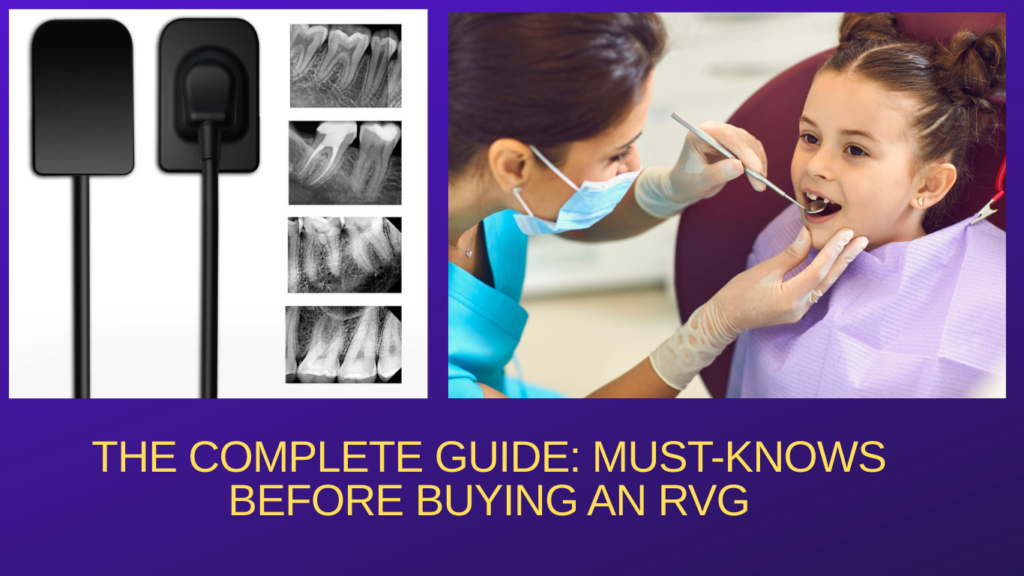As a dentist, investing in the right Radiovisiography or RVG system is crucial for your practice. RVGs are indispensable for obtaining high-quality digital X-rays, which enhance diagnostic precision, save time, and improve patient satisfaction. Before making this significant purchase, understanding the key features, types, and considerations is essential. This guide will help you make an informed decision.
1. What is RVG and Why Do You Need It?
Radiovisiography (RVG) is a digital dental imaging system that produces immediate, high-resolution X-ray images. It is crucial for:
- Better Diagnosis: High-quality images for precise treatment planning.
- Efficiency: Reduced patient waiting time.
- Cost-effectiveness: Eliminates the need for traditional X-ray films.
2. Types of RVG Systems
- Wired RVG Systems: Economical and reliable but limited by cable length.
- Wireless RVG Systems: Offers flexibility and ease of movement, suitable for multi-chair setups.
3. Key Features to Look For
When purchasing an RVG, focus on the following:
- Sensor Quality: Ensure the sensor provides high-resolution images (minimum 20 lp/mm).
- Size: RVG (Radiovisiography) sensors are available in different sizes to suit various dental applications. Choosing the right size ensures accurate imaging and patient comfort. Know in details- click here. Here’s a detailed guide is written below.
- Software Integration: Compatibility with your dental software for easy image management.
- Warranty and Support: Look for extended warranties and reliable after-sales service.
- Ergonomics: Lightweight sensors with flexible cables enhance usability.
- Durability: Waterproof and shockproof sensors last longer in busy practices.
- Data Sharing: Direct Data Export via Email, Cloud platforms storage, Pen drive, Print out & Wireless sharing via Bluetooth/ Wifi etc.
4. Budget and Pricing
RVG systems range from INR 70,000 to INR 5,00,000. While budget options are available, investing in a mid-range or premium system often ensures better image quality and durability.

5. Installation and Maintenance
- Ensure your clinic has the proper infrastructure for the device. Check is supported with your existing Xray machine, Computer/Laptop configuration.
- Routine sensor cleaning and software updates improve performance.
- Partner with suppliers offering quick installation and training.
6. Choosing the Right RVG Sensor: A Guide to Sizes and Shapes
RVG (Radiovisiography) sensors are available in different sizes to suit various dental applications. Choosing the right size ensures accurate imaging and patient comfort. Know in details- click here. Here’s a detailed guide to the common RVG sensor sizes, their numbers, and their specific uses:
A. Size 0 (Pediatric Sensor)
- Dimensions: Approx. 22 mm x 31 mm
- Usage:
- Specifically designed for children.
- Suitable for small oral cavities where larger sensors might cause discomfort.
- Ideal for capturing bitewing and periapical X-rays in pediatric dentistry.
- Benefits:
- Enhanced comfort for younger patients.
- Easy positioning in smaller mouths.
B. Size 1 (Anterior Sensor)
- Dimensions: Approx. 24 mm x 40 mm
- Usage:
- Commonly used for imaging adult anterior teeth.
- Ideal for canine-to-canine periapical views.
- Suitable for narrow arch patients.
- Benefits:
- Provides detailed images of anterior regions.
- Compact size improves positioning in tight spaces.
C. Size 2 (Standard Adult Sensor)
- Dimensions: Approx. 31 mm x 41 mm
- Usage:
- The most widely used sensor size for general dentistry.
- It is ideal for capturing bitewing, periapical, and occlusal views in adults.
- It can also be used in some older children.
- Benefits:
- Versatile and widely applicable for various imaging needs.
- The larger active area captures more diagnostic information.
D. Size 3 (Bitewing Sensor)
- Dimensions: Approx. 27 mm x 54 mm
- Usage:
- Specifically designed for bitewing X-rays in adults.
- It covers a broader area of the posterior teeth, reducing the number of images needed.
- Benefits:
- Saves time and minimizes radiation exposure by reducing the need for multiple images.
- Ideal for detecting interproximal caries and bone levels.
7. Reviews and Recommendations
- Read online reviews to understand user experiences.
- Consult with colleagues about the brands they trust.
- Attend dental expos to explore the latest RVG technologies.
Conclusion
Buying an RVG is a vital decision that can greatly enhance your dental practice. By evaluating your needs, researching the best options, and prioritizing quality over cost, you can invest in an RVG system that offers excellent value and reliability for years to come.
Make an informed choice and provide your patients with the care they deserve!
